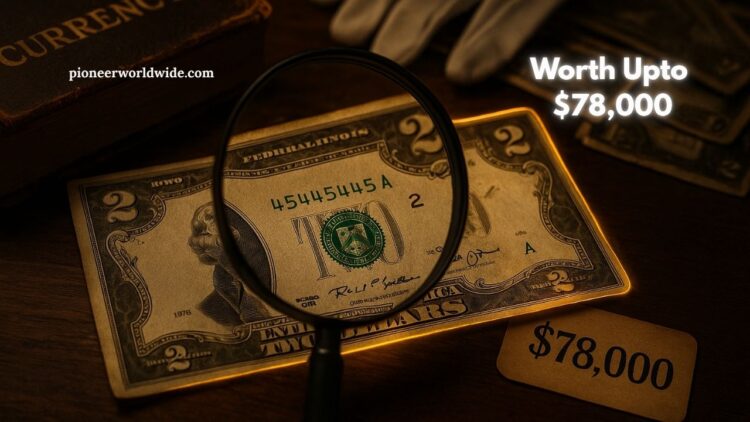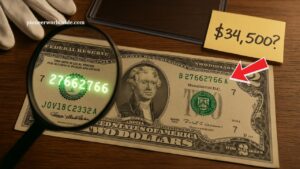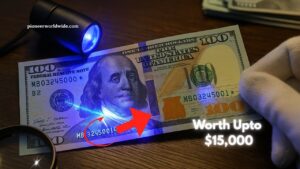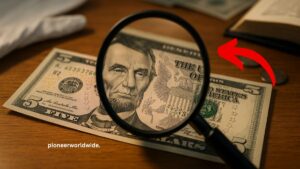That old $2 bill tucked away in your wallet could be worth far more than its face value. A rare 1976 Bicentennial $2 bill recently sold for a jaw-dropping $78,000—not because of a printing error, but due to its unique repeater serial number. With collectors now paying premium prices for special serial combinations, it’s time to inspect your bills carefully.
What Makes the 1976 $2 Bill Special?
The Bicentennial $2 bill, issued in 1976 to commemorate America’s 200th year of independence, holds historical significance. While most are worth only $2, certain features can transform them into collector’s gold.
One such feature is a repeater serial number—a sequence where numbers repeat in a pattern like 12121212 or 34343434. Combined with pristine condition and historical value, these patterns elevate the bill’s rarity and price.
Why Repeater Serials Are So Valuable
Serial numbers are crucial to collectors. A repeater serial number is defined as an 8-digit pattern where the first half mirrors the second, such as:
- 23232323
- 56565656
- 90909090
These serials are exceptionally rare and desirable because they add a unique layer of pattern recognition and symmetry to an already historical bill.
Value Comparison by Serial Pattern
| Feature | Estimated Value Range | Rarity Level |
|---|---|---|
| Repeater Serial + Uncirculated | Up to $78,000 | Ultra-Rare |
| Ladder Serial (e.g., 12345678) | $5,000 – $25,000 | Very Rare |
| Solid Serial (e.g., 77777777) | $3,000 – $20,000 | Rare |
| Star Note (with ★ symbol) | $1,000 – $10,000 | Collectible |
| Regular 1976 $2 Bill | $2 – $10 | Common |
How to Spot a Repeater Serial
To determine if your bill has a repeater serial, look at the 8-digit number printed twice—once in the upper right and once in the lower left. If the digits repeat in an obvious, symmetrical fashion, you may have a repeater.
Common Types of Repeater Serials:
- Two-digit repeaters: 12121212, 56565656
- Four-digit repeaters: 12341234, 98769876
- Full digit repeaters: 88888888 (also known as solid serials)
Condition also plays a vital role. A crisp, uncirculated bill with a flawless serial number will always command higher value.
Other Valuable Serial Number Patterns
Beyond repeaters, here are other serial types that increase a bill’s value:
- Ladders: Serial numbers in perfect sequence, like 12345678 or 87654321
- Low Numbers: Bills with serials like 00000001 or 00000123
- Palindromes: Reads the same forward and backward, such as 12344321
- Star Notes: Printed with a ★ symbol at the end, replacing damaged notes
These serials are not only rare but often considered artistic by collectors.
How to Preserve a Valuable $2 Bill
If you believe you’ve found a rare $2 bill, don’t rush to sell or spend it. Proper care can protect and increase its value:
- Do not fold or crease it – this significantly lowers its grade.
- Use a currency sleeve – store the bill in an acid-free, protective sleeve.
- Keep it flat and dry – avoid exposure to light, humidity, or heat.
- Avoid handling – oils from your hands can degrade the paper over time.
- Consider grading – certified grading services can authenticate your bill and assign it a marketable value.
What To Do If You Think You Have One
Here’s a quick checklist:
- Step 1: Examine the serial number for patterns (repeaters, ladders, palindromes).
- Step 2: Check the year—only 1976 bills are Bicentennial editions.
- Step 3: Look for a star symbol, unique print marks, or signatures.
- Step 4: If valuable, consider getting it professionally graded.
- Step 5: Preserve it and contact a trusted currency dealer or auction platform.
The recent $78,000 sale of a rare Bicentennial $2 bill with a repeater serial has reignited interest among collectors and casual holders alike. These bills are more than just currency—they’re artifacts of American history and creativity in print. So before you spend that $2 note, check the serial. You might just be holding a small fortune in your hands.
FAQs
What is a repeater serial number on a $2 bill?
A repeater serial number is a patterned number sequence like 12121212 or 34343434, which repeats the same digits in a structured format.
Are all 1976 $2 bills valuable?
No. Most are worth face value unless they feature rare serial numbers, printing errors, or are in uncirculated condition.
How do I know if my $2 bill is rare?
Check for unique serial numbers (like repeaters, ladders, low numbers, or star notes), year of issue, and condition. Grading and expert appraisal can confirm its value.




